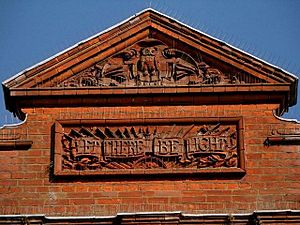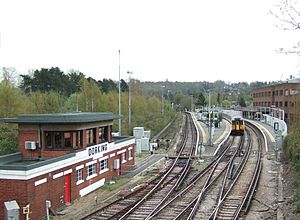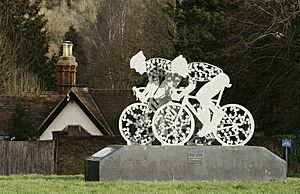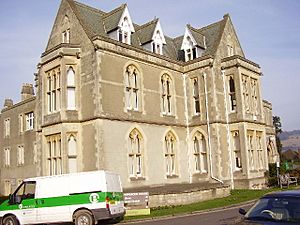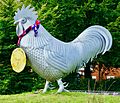Dorking facts for kids
Quick facts for kids Dorking |
|
|---|---|
| Market town | |
 View northeast from The Nower towards Dorking town centre and Box Hill |
|
| Area | 6.57 km2 (2.54 sq mi) town wards |
| Population | 11,158 town wards only 17,098 wider built-up area (2011 census) |
| • Density | 1,698/km2 (4,400/sq mi) |
| OS grid reference | TQ165494 |
| • London | 21 mi (34 km) NNE |
| Civil parish |
|
| District |
|
| Shire county | |
| Region | |
| Country | England |
| Sovereign state | United Kingdom |
| Post town | Dorking |
| Postcode district | RH4 |
| Dialling code | 01306 |
| Police | Surrey |
| Fire | Surrey |
| Ambulance | South East Coast |
| EU Parliament | South East England |
| UK Parliament |
|
Dorking is a market town in Surrey in South East England, about 34 km (21 mi) south of London. It is in Mole Valley District and the council headquarters are to the east of the centre. The High Street runs roughly east–west, parallel to the Pipp Brook and along the northern face of an outcrop of Lower Greensand. The town is surrounded on three sides by the Surrey Hills Area of Outstanding Natural Beauty and is close to Box Hill and Leith Hill.
The earliest archaeological evidence of human activity is from the Mesolithic and Neolithic periods, and there are several Bronze Age bowl barrows in the local area. The town may have been the site of a staging post on Stane Street during Roman times, however the name 'Dorking' suggests an Anglo-Saxon origin for the modern settlement. A market is thought to have been held at least weekly since early medieval times and was highly regarded for the poultry traded there. The Dorking breed of domestic chicken is named after the town.
The local economy thrived during Tudor times, but declined in the 17th century due to poor infrastructure and competition from neighbouring towns. During the early modern period many inhabitants were nonconformists, including the author, Daniel Defoe, who lived in Dorking as a child. Six of the Mayflower Pilgrims, including William Mullins and his daughter Priscilla, lived in the town before setting sail for the New World.
Dorking started to expand during the 18th and 19th centuries as transport links improved and farmland to the south of the centre was released for housebuilding. The new turnpike, and later the railways, facilitated the sale of lime produced in the town, but also attracted wealthier residents, who had had no previous connection to the area. Residential expansion continued in the first half of the 20th century, as the Deepdene and Denbies estates began to be broken up. Further development is now constrained by the Metropolitan Green Belt, which encircles the town.
Contents
History and development
Dorking began to become more than an agricultural village as a small staging post on Stane Street, the Roman road between London and Chichester on the English Channel.
Dorking appears in Domesday Book of 1086 as the Manor of Dorchinges. It was held by William the Conqueror. Its Domesday assets were: one church, three mills worth 15s 4d, 16 ploughs, 3 acres (1.2 ha) of meadow, woodland and herbage for 88 hogs. It rendered £18 per year to its feudal system overlords.
Subsequent Lords of the Manor included the Dukes of Norfolk, who lived in Dorking until they moved to Arundel. One of them is buried in Dorking churchyard. In the medieval period, Dorking was a prosperous agricultural and market town with businesses, including milling and brewing, capitalising on its position on the junction of a number of long distance roads and local tracks.
In 1750, the construction of a turnpike road made Dorking a staging post on the route to Brighton and the coast. The Bull's Head in South Street had a famous coachman, William Broad, whose portrait hangs in Dorking Museum in West Street. An inn in the centre of Dorking, the White Horse, was developed in the 18th century; previous buildings on this site belonged to the Knights Templar and later the Knights of St John.
Dorking held a big wheat and cattle market in the High Street. The poultry market was held in the corner of South Street and round Butter Hill. Here the famous Dorking fowl were sold. This breed, which has five claws instead of the normal four, was a favourite for 19th century tables, including that of Queen Victoria.
Dorking lost its stagecoaches when the railways arrived, but then attracted wealthy residents who built large houses in and around the town, such as Denbies House and Pippbrook House (now with council offices in the grounds). Surrounding land and beauty spots such as Cotmandene and Box Hill were donated by landowners for public use, protected by the Metropolitan Green Belt and the AONB designation of the North Downs and Greensand Ridge.
Cotmandene is a 4.78 ha (12-acre) area of common land to the east of the town centre, (the name is thought to mean the heath of the poor cottages).
A game resembling rugby was once played here. The two sides were unlimited in number, representing the east and west of the town. The goals were the two bridges on the Pipp Brook. The Town Crier kicked off the ball at 2 pm and stopped play at 6 pm. The game was started at the church gates and was "rioted" up and down the High Street. It ceased in 1897 after complaints by tradesmen and it was officially stopped under section 72 of the Highway Act 1835.
Dorking was an urban district from 1894 to 1974. In 1911 it was described in the Victoria County History, compiled for the county that year and the next, as "almost entirely residential and agricultural, with some lime works on the chalk, though not so extensive as those in neighbouring parishes, a little brick-making, water-mills (corn) at Pixham Mill, and timber and saw-mills."
Geography
The town is in the west of the area between hill ranges in southern England known as Holmesdale which has headwaters of several rivers. The town's geography is undulating; for example, the elevation of the southern point of the central one-way system is 76 metres and on its northern side the elevation is 59–60 metres. The Mole's nearest point to the town lies at 45 metres.
Just northeast of the town the River Mole cuts a steep-sided valley through the North Downs. On the west bank is Denbies Vineyard, the largest vineyard in the UK. On the east bank is Box Hill, owned by the National Trust and Britain's first Country Park. The hill has been designated a Site of Special Scientific Interest, because of the large number of rare orchids which grow there in the summer.
Further north is Norbury Park, which contains the Druids Grove, a forest of ancient yew trees.
To the south west of the town is Leith Hill, also owned by the National Trust, the second highest point in the south east of England after Walbury Hill. The tower on the summit elevates the hill to 1,000 ft (300 m) above sea level. The area is towards the east of the Surrey Hills AONB surrounded by the Greensand Ridge, including Holmbury Hill and Pitch Hill, as well as the nearby escarpment of the North Downs from Box Hill to Newlands Corner.
A species of fish-eating dinosaur, Baryonyx walkeri, was discovered in clay pits just south of Dorking. The creature had a long curved claw on each hand and remains of its last meal were discovered fossilised in its ribcage. The skeleton can be seen at the Natural History Museum in London. One disused clay pit (Inholms lane) is now open to the public as a nature reserve.
 |
Great Bookham | Westhumble | Pixham, Box Hill, Headley |  |
| Westcott | Brockham | |||
| Coldharbour | North Holmwood | Newdigate |
Climate
Dorking experiences an oceanic climate (Köppen climate classification Cfb) similar to almost all of the United Kingdom.
Amenities and landmarks
Much of the original character survives, whilst accommodating businesses that serve the needs of the 21st century. The town is well known for its antique dealers. The town's three main trading streets of High Street, West Street and South Street are complemented by a small open-air shopping centre, St Martin's Walk, which is adjacent to the town's main car park and easily accessed from the High Street.
In the late 1990s Dorking Halls was given a huge refit, to make it a cinema and theatre complex. In 2003 a new modern leisure centre and swimming pool were added to the Dorking Halls Complex.
There is a thin, somewhat shiny metal statue of a Dorking cockerel on the Deepdene roundabout.
Dorking and nearby Box Hill were chosen as part of the route for the 2012 London Olympics cycling road race and have featured in the FIA-ranked London-Surrey cycle classic every year since.
In the mid-1960s the Goodwyns council estate was built at the south end of the town, adjacent to North Holmwood. The design of the terraced houses, three- and four-storey flats and twin eleven-storey tower blocks was praised by architectural historians Ian Nairn and Nikolaus Pevsner.
The Deepdene Trail, a heritage walking trail, opens in September 2016 offering walks for all levels of fitness in a quiet space just 15 minutes from Dorking High Street.
Transport
Roads
The A24 London-Worthing and the A25 Guildford-Sevenoaks roads intersect at Deepdene Roundabout on the eastern side of Dorking. The one-way system in the town centre was introduced in 1968.
Railways
The Epsom-Horsham and Guildford-Reigate railway lines cross to the northeast of Dorking, but there is now no physical connection between the two. The town is served by three railway stations. Dorking is managed by Southern and is served by trains to London Victoria via Sutton, to London Waterloo via Wimbledon and to Horsham. Dorking Deepdene and Dorking West stations are managed by Great Western Railway and are served by trains to Reading via Guildford and to Gatwick Airport via Redhill.
Buses
Route 32 from Dorking to Guildford via Shere and to Redhill via Earlswood is run by Compass Bus. Route 93 from Dorking to Horsham via Goodwyns and Holmwood Park is run by Metrobus on behalf of Surrey County Council. Route 465 from Dorking to Kingston upon Thames via Leatherhead is run by London United. Routes 21 (Epsom – Dorking – Crawley) and 22 (Shere – Dorking – Crawley) are run by Metrobus.
Cycle routes
National Cycle Route 22 passes through the town centre and the Surrey Cycleway runs to the east.
Long distance footpaths
The Greensand Way, a 174 km (108 mi) long-distance footpath from Haslemere, Surrey to Hamstreet, Kent, passes through the south of Dorking. The route approaches the town centre from the east, passing over The Nower, then crossing the junction between South Street and Horsham Road. It climbs through the Glory Wood, before crossing Deepdene Terrace. The North Downs Way, between Farnham and Dover, passes approximately 1 km (0.62 mi) to the north of Dorking. Dorking station is the southern terminus of the Mole Gap Trail, which starts at Leatherhead.
Leisure and culture
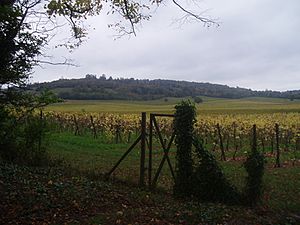
On 15 June 2004, Dorking was granted Fairtrade Town status.
The Dorking Halls is a cinema, theatre, leisure centre and swimming pool complex. There is also an "Arts Alive" Festival which takes place annually during the last two weeks of October. Dorking Halls is also yearly host to a professional pantomime which was re-introduced in December 2006, after several years of hosting Zippo's Circus.
Dorking also has a museum, a library, about twenty pubs and a CIU affiliated club. It is noted for its antique and art shops on West Street. Dorking has two Non-League football clubs Dorking Football Club who play at county level and are based in the centre of the town and play at the Meadowbank. Dorking Wanderers F.C. play at the Dorking Wanderers Stadium, which is near Westhumble.
Dorking rugby football club, which plays at Brockham, attracted national attention when it won the Powergen Vase in 2005/2006 and continues to do so having won promotion from National League 3 (London & South East) to National League 2 South and Surrey Cup double in 2014. Dorking and Mole Valley Athletics Club is based at Pixham Sports Ground. They host the annual Dorking Ten road race starting from Brockham Green. Dorking also has a cycling club that meets on Sunday mornings at the Sports Centre in Reigate Road at 8:45, offering group rides for all abilities and cycling interests. Peter King CBE former Chief Executive of British Cycling is the Honorary President of Dorking Cycling Club. The Mole Valley Bowmen meet in the grounds of St Martin's primary school.
Near to Dorking lies the Leith Hill escarpment of the Greensand Ridge, including the hills of Holmbury Hill and Pitch Hill, as well as the nearby escarpment of the North Downs from Box Hill to Newlands Corner. Both ridges are notable in southern England for country walks, rambling and mountain biking, and the town in one of the narrowest gaps between high parts of them has a number of premises catering to these pursuits. Part of the 'Vale of Holmesdale', much of the post town but not town itself is within the Surrey Hills AONB. Also adjacent to Dorking is Denbies Vineyard. The Dorking Group of Artists exhibit locally twice a year, in Betchworth and at Denbies. They celebrated their 60th anniversary in 2007.
Underneath part of the town centre are the Dorking Caves which are open occasionally to the public and were dug for sand, mostly in the 19th century.
Leith Hill Music Festival
Each year in April, the town plays host to the Leith Hill Music Festival for local choral societies. This was founded in 1905 by Margaret Vaughan Williams, sister of the composer Ralph Vaughan Williams, and Lady (Evangeline) Farrer, wife of Lord Farrer of Abinger Hall. Ralph Vaughan Williams was the Festival Conductor from 1905 to 1953. The present Festival Conductor is Brian Kay.
The festival is competitive lasting three days, each day with a different division of choirs; each evening the choirs who have competed during the day combine to give a concert of the works which form the subject of the competitions. Following the tradition established by Vaughan Williams, the St. Matthew Passion or the St. John Passion of J. S. Bach are also frequently performed by the combined choral societies.
After the death of Vaughan Williams in 1958 the festival committee commissioned, from David McFall A.R.A., two identical bronze plaques with a likeness of the composer; one was placed in St. Martin's church and one in the Dorking Halls. In 2001 a smaller than life size bronze statue of Vaughan Williams by William Fawke was erected outside the Dorking Halls.
Demography and housing
In the 2011 Census, the combined population of the Dorking North and South wards was 11,158. The larger "built-up area" (which includes the Goodwyns estate, North Holmwood, Pixham and Westhumble, in addition to the two town wards) had a population of 17,741.
| Ward | Detached | Semi-detached | Terraced | Flats and apartments | Caravans/temporary/mobile homes/houseboats | Shared between households |
|---|---|---|---|---|---|---|
| Dorking North | 378 | 548 | 451 | 465 | 0 | 0 |
| Dorking South | 865 | 695 | 417 | 1,045 | 0 | 3 |
| Ward | Population | Households | % Owned outright | % Owned with a loan | hectares |
|---|---|---|---|---|---|
| Dorking North | 4,157 | 1,842 | 34 | 38 | 255 |
| Dorking South | 7,001 | 3,025 | 34 | 32 | 402 |
| Regional average | 35.1 | 32.5 |
Dorking North ward excludes Pixham and Westhumble. Dorking South ward excludes North Holmwood and the Goodwyns estate.
Sport
Shrove Tuesday football
A football game was played annually in Dorking on Shrove Tuesday between two teams representing the eastern and western halves of the town. The match began at 2pm outside the gates to St Martin's Church and lasted until 6pm. After a particularly riotous game in 1897, the local magistrates declared that the tradition was in breach of the Highway Act 1835 and 50 participants were fined. Arrests were also made after local townsfolk attempted to stage the match in 1898, 1899 and 1903. The local newspaper declared the custom extinct in 1907.
Association football
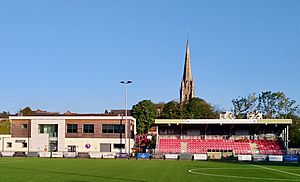
Dorking F.C. was formed in 1880 and moved to Meadowbank in 1956. The stadium was condemned as unsafe in 2013 and for the next three years, the club shared grounds, first at Horley and then Westhumble. Dorking F.C. closed in 2017.
Dorking Wanderers F.C. was founded in 1999. The team played its home games at Westhumble for ten seasons from 2007, before moving to the refurbished Meadowbank Stadium in July 2018.
Rugby
Dorking rugby football club was founded in 1921. Initially its home matches were played at Meadowbank, but it moved the following year to Pixham. In 1972 the club relocated to the Big Field at Brockham as tenants of the National Trust, which had acquired the field in 1966. In the 2019–20 season, the 1st XV played in the London and South East Premier division. Notable former players include Elliot Daly, George Kruis and Kay Wilson.
Motor racing
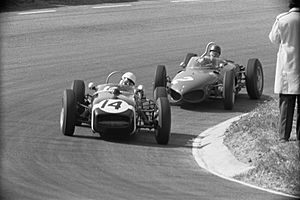
Rob Walker's privateer racing team was based at Pippbrook Garage in London Road from 1947 to 1970. The team won nine Grands Prix and their drivers included Stirling Moss (1958–1961) and Graham Hill (1970). Walker's contribution to motorsport and to Dorking was celebrated on the centenary of his birth in October 2018 with a parade of classic cars through the town centre.
Cycling
Dorking Cycling Club was founded in 1877 and by the 1890s was organising camps for amateur cyclists from across the south east of England. The club was refounded in 2011 and organises a programme of weekly rides for members. The 2012 Summer Olympic cycling road races passed through Dorking en route to Box Hill.
Running
Dorking and Mole Valley Athletics Club is based at Pixham Sports Ground. They host the annual Dorking Ten road race starting from Brockham Green.
The weekly Mole Valley Parkrun has taken place at Denbies Wine Estate since March 2018. The vineyard also hosts the annual Run Bacchus marathon. The annual Wife-Carrying Race takes place at The Nower.
Education
Primary schools
There are five primary schools in Dorking, the oldest of which is Powell Corderoy School. It was founded in 1816 as The Dorking British School, and its original premises were in West Street; but twenty years later it moved to North Street. Towards the end of the nineteenth century, the school had expanded and the funds for a new building in Norfolk Road were raised by Edith Corderoy and Mr T. Powell. The new site was opened in 1898 and the school adopted its present name in 1906. The school moved to its current location in Longfield Road in 1968.
St Martin's Primary School was founded as a National School by the vestry in the 1830s, however there is thought to have been a school located in the transepts of the parish church as early as the 17th century. The National School was moved from the grounds of the church to West Street in 1862. The Middle School relocated to Ranmore Road in 1969 and was joined by the First School in 1985. The Pixham First School was founded in 1880 by Mary Mayo and was built to a design by Gilbert Redgrave. St Paul's Primary School was founded in 1860.
St Paul's School was designed by the architect, Thomas Allom, and admitted its first pupils in March 1860. The infants department opened in 1872 and, from that year, the school educated children aged from 5 to 13. Today, St Paul's is a Church of England Voluntary Aided Primary School and educates children from the ages of 5 to 11.
St Joseph's Catholic Primary School was founded in 1873 by Augusta Fitzalan-Howard, Duchess of Norfolk. The first premises were in Falkland Grove adjacent to St Joseph's Church. The school was run by nuns of the Servite Order from 1887 to 1970, when it moved to its present site in Norfolk Road, which had been vacated by Powell Corderoy School.
St John's Primary School was founded in 1955 on the Goodwyns housing estate to the south of the town. It was known as The Redlands Junior School until August 1999.
New Lodge School, an independent prep school formed in 2002 from the merger of Stanway School and Nower Lodge School, closed in 2007.
Secondary schools
The Ashcombe School is a coeducational secondary school, north of the town centre. It traces its origins to the Dorking High School for Boys, founded in 1884, and the St Martin's High School for Girls, opened in 1903. In 1931, the two schools were merged to become the Dorking County School and moved to a new site in Ashcombe Road. In 1959 the Mowbray County Secondary Modern for girls was opened on an adjacent site. The two schools were combined to create the Ashcombe School in 1975.
The Priory School opened as the County Secondary Modern Mixed School in September 1949. It was initially based at the Dene Street Institute, but moved to its present location in West Bank within a few years. In 1959, the girls were transferred to the Mowbray School in the Ashcombe Road, and Sondes Place continued as a boys-only school. In 1976 it became a mixed comprehensive school and was renamed the Priory School in 1996.
Notable residents
Three former residents of Dorking have been awarded the Victoria Cross (VC):
- Sir William Leslie de la Poer Beresford was given his VC for rescuing a comrade at Ulundi (now in South Africa) during the 1879 Anglo-Zulu War. After retiring from the army, he lived at the Deepdene with his wife, the Dowager Duchess of Marlborough.
- Sir Lewis Halliday was awarded the VC for repelling an enemy attack during the 1899-1901 Boxer Rebellion in China. He died in Dorking in 1966.
- Charles Graham Robertson was given his VC for repelling an enemy attack during the German spring offensive in March 1918. On his return to Dorking after the war, he was honoured with a parade and the presentation of a gold watch. He continued to live in the town until his death in 1954 and is buried in the cemetery.
People born in the town include:
- Laurence Olivier (1907–1989), actor and director. A blue plaque marking his birthplace can be found in Wathen Road.
- Walter Dendy Sadler (1854–1923), artist and painter.
- Jamie Mackie (born 1985) former Scotland international football player.
People who have lived in the town include:
- Daniel Defoe (c.1660–1731), who attended Rev. James Fisher's boarding school in Pixham Lane, and later mentioned Dorking in his Tour thro' the whole island of Great Britain.
- Peter Labilliere (1725–1800), a former Army Major and political agitator lived in a cottage on Butter Hill from 1789. In accordance with his wishes he was buried head downwards 11 June 1800 on the western side of Box Hill.
- The composer Ralph Vaughan Williams (1872–1958) lived in Dorking from 1929 to 1951. One of his most famous works, The Lark Ascending, was inspired by a poem of the same name published in 1881 by the author George Meredith, who lived at Box Hill.
- Composer David Moule-Evans (1905–1988) collaborated with Vaughan Williams on the pageant play England's Pleasant Land, written by E.M. Forster, which was first performed in Dorking in 1938.
- Absolute Radio DJ Christian O'Connell lived in Dorking for several years until 2018.
Images for kids
-
A female Dorking chicken
-
The "Dorking Cockerel" photographed during the London 2012 Olympic Games
See also
 In Spanish: Dorking para niños
In Spanish: Dorking para niños



